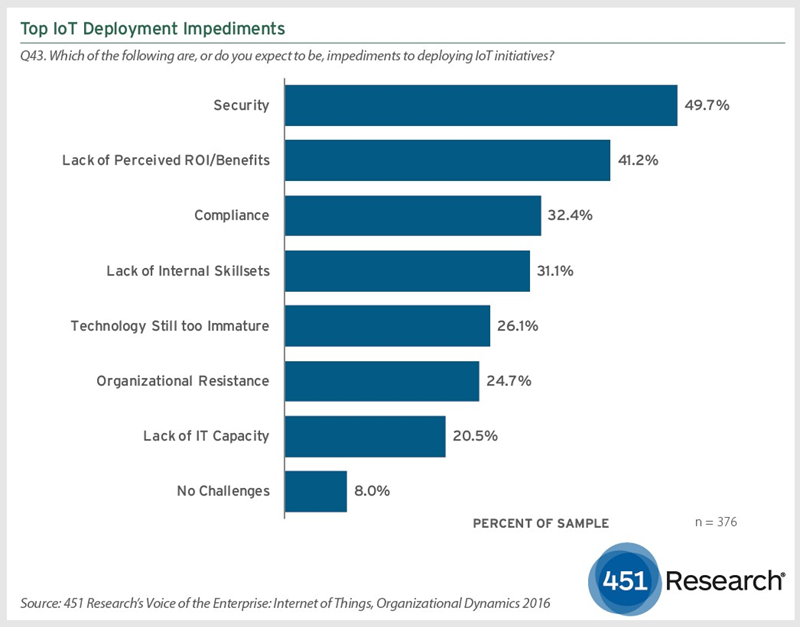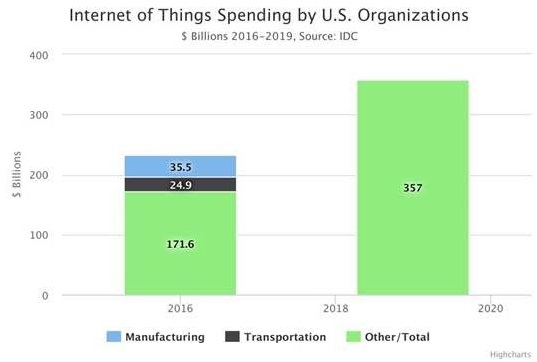451 Research: 71% Enterprises Gathering Data for IoT
451 Research, an information technology research and advisory company, conducted a survey entitled Internet of Things (IoT) Organizational Dynamics, and the survey disclosed that 71% of enterprises are gathering data for IoT initiatives today.
“When it comes to IoT adoption, pragmatism rules,” said Laura DiDio, Research Director at 451 Research and  lead author of the study. “The survey data indicates enterprises currently use IoT for practical technology purposes that have an immediate and tangible impact on daily operational business efficiencies, economies of scale and increasing the revenue stream.”
lead author of the study. “The survey data indicates enterprises currently use IoT for practical technology purposes that have an immediate and tangible impact on daily operational business efficiencies, economies of scale and increasing the revenue stream.”
According to the survey of nearly 1,000 enterprise IT buyers worldwide, 50% of respondents said that security is the biggest hindrance to IoT deployments. The second top impediment is IoT's lack of perceived Return on Investment (ROI) and benefits with 41%. However, despite the challenges cited in the survey, there is a silver lining among the key findings in favor of the industry: Enterprises expect to increase their IoT investment 33% over the next 12 months. The following impediments are demonstrated in the chart below:

IoT Organizational Dynamics study focuses on enterprise end-user adoption and the business and technology drivers associated with IoT and related data analytics adoption and challenges. Based on research conducted in August through October 2016 with nearly 1,000 enterprise IT professionals worldwide, the quarterly study combines 451 Research’s analysis with survey responses and in-depth interviews with a panel of more than 48,000 senior IT buyers and enterprise technology executives. The other key findings from the study:
-
90% of enterprises will increase IoT spending over the next 12 months and 40% of respondents will raise IoT-related investment by 25% to 50% compared to 2016.
-
Enterprises are split regarding a present IoT skills shortage: 54% of respondents to this question said lack of trained IoT staff is not an issue for their organization, versus 46% who said they are having difficulty filling IoT-related positions. The latter group identified IoT security and data analytics as the areas with the greatest dearth of expertise.
-
68% of corporations currently take advantage of IoT data to optimize operations, such as performing preventative maintenance, reducing downtime in factory equipment and fleet management.
-
42% of enterprises use IoT data to develop new products or enhance existing products and services.
All these findings bring the fact to light that the growth of IoT devices is virtually exploding. Some big players even reinvent themselves in order to adapt to the IoT market. Cisco and Intel, for instance, announced massive layoffs in their traditional businesses to focus on IoT. Cisco said in August that it would shed 5,500 staff as it "refocuses on IoT, security, next-generation data centers and cloud" services. Intel announced at last week's Intel Developers Forum that it would concentrate on IoT and virtual reality followed its decision in April to lay off 12,000 employees, most of them involved with Intel's historic (but slowing) personal computer activities. Samsung, for example, announced that by 2020, 100 percent of Samsung Digital appliances will be connected.
Another study conducted by IDC, U.S. organizations will invest more than $232 billion in Internet of Things (IoT) hardware, software, services, and connectivity this year. And, IDC expects U.S. IoT revenue will experience a compound annual growth rate (CAGR) of 16.1% over the 2015-2019 forecast period, reaching more than $357 billion in 2019. While Manufacturing and Transportation will lead the U.S. in terms of overall IoT investments, the Insurance, Retail, and Healthcare industries will see IoT spending levels increasing by 135%, 101%, and 96% respectively, over the forecasted period.

Nevertheless, still, its business benefits have not yet been articulated and quantified by most enterprises. Here’s why enterprises should capitalize on the IoT technology:
-
Enhancements to business process: "We do what we normally do, but digitalization allows us to do it better or develop better products within our industry," said Hung Le Hong, research Vice President and Gartner fellow.
-
Customer experience: The relations between the customer and the product company does move from a one-time interaction to arm's-length transaction. To me, this is a major opportunity. By leveraging IoT solutions, businesses can be proactive in terms of customer service.
-
Efficiency: Instead of sending maintenance crews to the site, companies can use data gathered from connected devices and decode through advanced analytics to see if the equipment and machinery in the field work properly. Maintaining a comfortable work environment and cutting energy costs at once are possible with the sensors connected to the commercial buildings. To reduce downtime and increase efficiency while boosting plant output in the same period of time by automatically redirecting workloads, manufacturers can connect their production-line systems to.
-
Encouraging and engineering new business models: Google, for example, now produces driverless cars to integrate with the automotive industry. A decade ago, would you think of google expanding to that industry? Highly unlikely.
-
Faster and Strategic Decision Making: Data originating from things creates a vast pool of information. Processing and analyzing this data can generate real-time operational insights to make faster and smarter business decisions and reduce operating costs.
-
Cost reduction: As a result of the benefits listed above, businesses will generate more revenue from the new business models and leveraged customer relationship while reducing the cost caused by inefficiency.
In conclusion, more and more businesses are looking to integrate IoT into their organizations and offerings, as it lowers operating costs, increases productivity, and gives organizations the opportunity tap into new markets. Those who are struggling to find their place in the IoT-enabled landscape should discover the business case first, and then plan out the large-scale deployment around that. As Gartner said: “going digital is not an option, not an add-on, and not an afterthought.” After ensuring the security of devices and the privacy of users, enterprises must implement this new-generation technology by phases as the internet of things has officially moved past the initial hype phase. The first step is, typically, turning passive devices into active devices. From there, managing these active devices. Ultimately, investments are needed to integrate the data from the devices to the organization’s enterprise systems.

Venus Tamturk
Venus is the Media Reporter for CMS-Connected, with one of her tasks to write thorough articles by creating the most up-to-date and engaging content using B2B digital marketing. She enjoys increasing brand equity and conversion through the strategic use of social media channels and integrated media marketing plans.